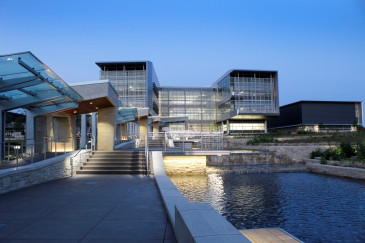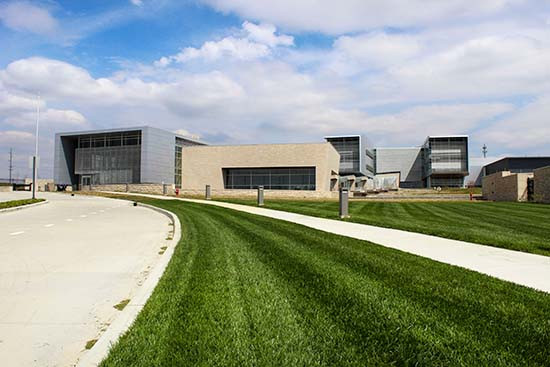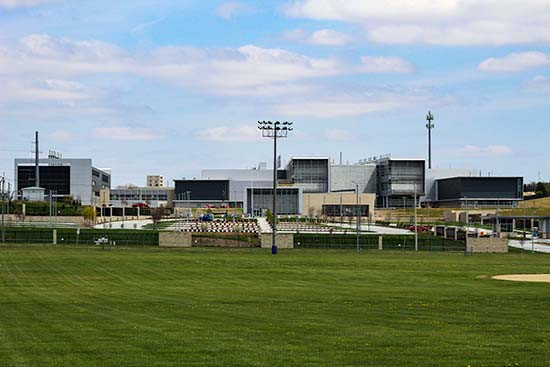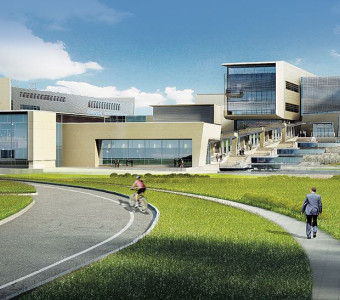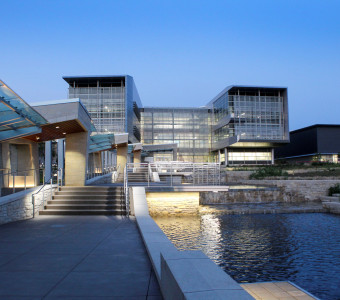NBAF Staff Anticipates Facility Completion and Commissioning This Year
Mar 21, 2022
For more than 15 years, the federal government has been planning and then building a biosafety level 3 (BSL-3) and 4 (BSL-4) facility within the continental United States to research foreign animal diseases in livestock and zoonotic pathogens (those that can transfer from animals to humans).
In spring 2022, construction on the U.S. Department of Agriculture’s National Bio and Agro-Defense Facility (NBAF) in Manhattan, Kansas, finally will be complete. A few months later, the facility’s commissioning also will be done, meaning all the facility’s systems have been thoroughly tested to ensure they are working correctly and with the highest safety standards.
When fully operational, NBAF will have more than 400 full-time employees in a combination of operational and scientific roles. Today, more than 240 people have been hired as part of our operations team, and about 70% of those have already been on-boarded during what the federal government calls a period of “maximum telework” — a time when as many employees as possible have been working at home due to the pandemic.
A Challenge: Recruiting an Expert Team During a Pandemic
For Dr. Alfonso Clavijo, who was hired in October 2019 as NBAF’s first director, building a team of worldwide experts during a global pandemic was certainly not ideal. Clavijo was on the job for only six months before the pandemic hit in March 2020 and caused everyone to work from home. He points out that not many organizations can say they overcame the challenge of recruiting and onboarding an entire elite workforce virtually — while building their physical facility at the same time.
“What’s most important about running an organization with 240 employees — and standing up a new operation while on telework — is everyone’s spirit and commitment to our mission. That’s what keeps me motivated every day — how everyone is ready to do the work and support each other,” Clavijo said. “It’s been an honor and a privilege to be a part of this project.”
One advantage of this past two years of telework has been that people who were hired from throughout the country had time to plan their move to Manhattan.
“It gave our staff flexibility to onboard virtually and have time to organize their move, find schools for their kids, housing and so forth,” Clavijo said. “This really helped these families, rather than giving them just a month or two to plan. We’ll continue to see more people relocating to the region over the next few years.”
At the time of this writing, Clavijo and several other personnel in engineering, utilities, and security were already working on-site at NBAF. This is possible as parts of the building’s construction are finished. But between the end of March and the end of May 2022, most of the rest of the already onboarded team will move into the building in phases. Bringing employees into the building in small cohorts will make it easier to train everyone in the building’s safety and security protocols.
Katie Pawlosky, NBAF’s communications director, reports there are still more than 150 additional positions to fill or move to NBAF from Plum Island in the coming months, many that simply weren’t needed on site until construction was complete. Most of these positions will support NBAF’s science and research units, as about 80% of NBAF’s operations positions have been hired.
“But with more than 400 positions in all, it’s safe to say from now on we’ll always be hiring,” Pawlosky said.
Anyone interested in operational or scientific positions is encouraged to continue to watch listings and apply at usajobs.gov. Jobs are also promoted on Twitter and LinkedIn.
Building OneNBAF
As well as hiring new people as federal employees, NBAF also brings together staff currently working through two different agencies: the USDA’s Animal and Plant Health Inspection Service (APHIS) and the USDA’s Agricultural Research Service (ARS).
Each of these agencies play a key role in USDA with respective expertise that when brought to NBAF, creates a rounded approach to protecting the nation from emerging foreign animal and zoonotic diseases. At NBAF, APHIS employees will contribute to their agency mission by focusing on prevention, surveillance, diagnosis and response to foreign animal diseases, including the expertise to manage the nation’s two vaccine banks. ARS employees at NBAF will contribute by conducting research and are charged with finding solutions to detect and control foreign animal diseases.
By having employees with expertise from both agencies working together at the same facility, NBAF will create a web of protection — including developing vaccines and other countermeasures for foreign animal and zoonotic diseases that could impact our nation’s food supply and public health. Much internal attention has been put into bringing these teams and agency cultures together to create what Clavijo calls “OneNBAF.”
“The two agencies have very different missions, but they are very complementary, and we will have to work together,” Clavijo said. “NBAF is a unique model for how we can achieve bigger things with two agencies under one roof.”
Pawlosky said NBAF’s leadership and communications teams have prioritized helping the new team members connect by hosting virtual lunch-and-learns, social events and team-building training. In addition, since the pandemic began, the entire staff has had a weekly virtual all-hands meeting to keep everyone in the loop and well informed about the project’s progress.
“We’ve done many things to help people get to know one another and these worked really well for a while, but eventually everyone had virtual meeting fatigue,” Pawlosky said. “Now that we’re used to teleworking, we will have to re-adjust to the changes that come with working together in person and outside our homes. We have had to be attuned to our employees and adapt to the ever-changing challenges together. Ultimately, this will make us a stronger team.”
Pawlosky notes they’ve been especially proud of work done through an initiative called NICE — NBAF Inclusive Council for Engagement. NICE Committees were formed to help different groups — women, racial and ethnic minorities, veterans and employees with disabilities — feel welcome, celebrate diversity and build a sense of community. These groups were created before the pandemic but have helped connect employees despite working from home and will continue as the staff transitions to working in person.
Some Telework May Continue
While NBAF’s leadership is excited to see their team physically moving into the building, in order to be responsive to the changing expectations many employees have developed during the pandemic, USDA has also created a clear policy related to telework. With those new policies in place, some NBAF employees are eligible to continue working from home, either full time or for as many as eight days every two weeks (depending on the position).
Of course, not all jobs can be done remotely, Clavijo added. The final decision of whether an employee will be granted the opportunity to telework will be between individual employees and supervisors.
“The pandemic has taught all of us the importance of being flexible, but we still need to ensure we have human contact and interaction in order to work together as a team. You must have a balance,” Clavijo said. “We simply can’t live 100% in the virtual world to achieve our mission.”
Training Staff and Transitioning Work from Plum Island
Clavijo’s team has been working closely with partners at Kansas State University, other universities and the USDA Center for Grain and Animal Health Research in Manhattan to start doing research and training. For example, he said NBAF’s Animal Resource Unit has been collaborating with K-State’s College of Veterinary Medicine to give employees hands-on livestock handling opportunities ahead of having animals at NBAF. Additionally, the new Foreign Arthropod-Borne Animal Disease Unit that recently started at NBAF has been partnering with K-State’s Department of Entomology and the Biosecurity Research Institute to begin research related to vector-borne diseases.
Despite these collaborations, a majority of the work continues for now at the 68-year-old Plum Island Animal Disease Center (PIADC) in New York. Some scientists currently working at PIADC, including some who were hired knowing their position would later be relocated to Kansas, will begin to move to the area in late 2022 or early 2023.
However, Clavijo said before any work with pathogens can begin at NBAF, all the procedures, protocols, workflows, and equipment must be in place and determined to be safe and effective. This includes work APHIS now does at PIADC to diagnose foreign animal diseases.
“There needs to be redundancies in testing abilities in place at both PIADC and NBAF before the full transition happens,” Clavijo said. “It has to be seamless.”
Will There Be a Ribbon Cutting?
While there is much more work to be done before the project is considered complete, Clavijo recognizes that many people in the Manhattan and K-State communities have worked hard to bring NBAF to the area for many years, and that dedication needs to be celebrated.
His team is working with the Department of Homeland Security and USDA to figure out the details of some type of ribbon-cutting event later this year.
To learn more about NBAF, its capabilities and mission, and job opportunities, visit usda.gov/nbaf. To learn more about opportunities for private industry to locate near NBAF, please contact the Greater Manhattan Economic Partnership.

